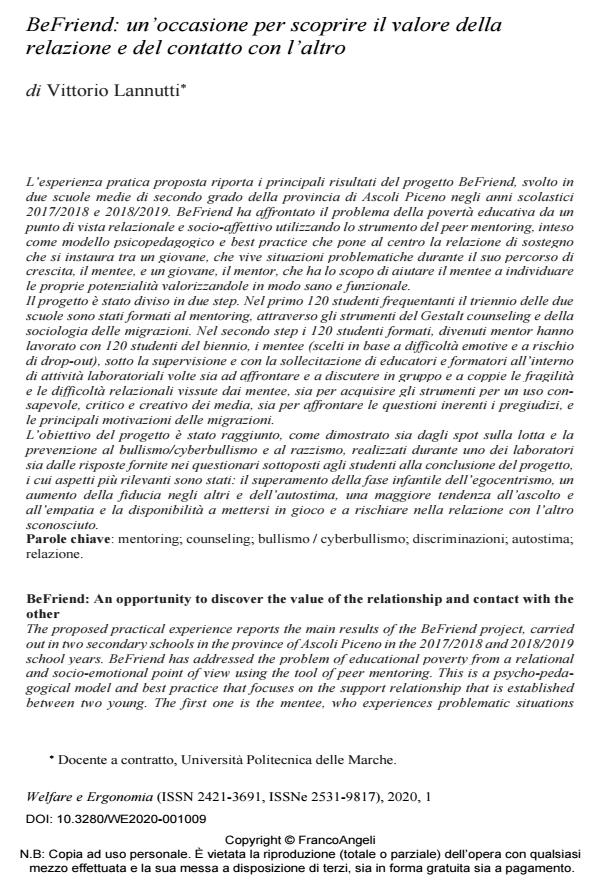BeFriend: An opportunity to discover the value of the relationship and contact with the other
Journal title WELFARE E ERGONOMIA
Author/s Vittorio Lannutti
Publishing Year 2020 Issue 2020/1
Language Italian Pages 10 P. 91-100 File size 340 KB
DOI 10.3280/WE2020-001009
DOI is like a bar code for intellectual property: to have more infomation
click here
Below, you can see the article first page
If you want to buy this article in PDF format, you can do it, following the instructions to buy download credits

FrancoAngeli is member of Publishers International Linking Association, Inc (PILA), a not-for-profit association which run the CrossRef service enabling links to and from online scholarly content.
The proposed practical experience reports the main results of the BeFriend project, carried out in two secondary schools in the province of Ascoli Piceno in the 2017/2018 and 2018/2019 school years. BeFriend has addressed the problem of educational poverty from a relational and socio-emotional point of view using the tool of peer mentoring. This is a psycho-pedagogical model and best practice that focuses on the support relationship that is es-tablished between two young. The first one is the mentee, who experiences problematic situa-tions during his growth path, the second one is the mentor, who has the aim of helping the mentee to identify his/her potential by enhancing them in a healthy and functional way. The project was divided into two steps. In the first 120 students, that are 16 and 17 old, were trained in mentoring, through the tools of Gestalt counseling and sociology of migration. In the second step, the 120 students trained, who became mentors, worked with 120 students younger, the mentees (chosen on the basis of emotional difficulties and risk of drop-out), un-der the supervision of educators and trainers within laboratory activities aimed at addressing and discussing in a group and in pairs the fragility and relationship difficulties experienced by the mentees. So they acquired the tools for a conscious, critical and creative use of the social media, rìthe knoweldges about the main causes of migration and how to face and mange prejudice issues. The aim of the project was achieved, as shown both by the commercials on the fight and prevention of bullying/cyberbullying and racism, carried out during one of the workshops and by the answers provided in the questionnaires submitted to students at the conclusion of the project. The most important aspects of which significant emerged were: the overcoming of the infantile phase of egocentrism, an increase of other's trust and of the self-esteem, a greater tendency to listen and to be in empathy, the willingness to get involved and to risk in the relationship with the other unknown.
Keywords: Mentoring; counseling; bullying / cyberbullying; discrimination; self-esteem; rela-tionship.
Vittorio Lannutti, BeFriend: un’occasione per scoprire il valore della relazione e del contatto con l’altro in "WELFARE E ERGONOMIA" 1/2020, pp 91-100, DOI: 10.3280/WE2020-001009